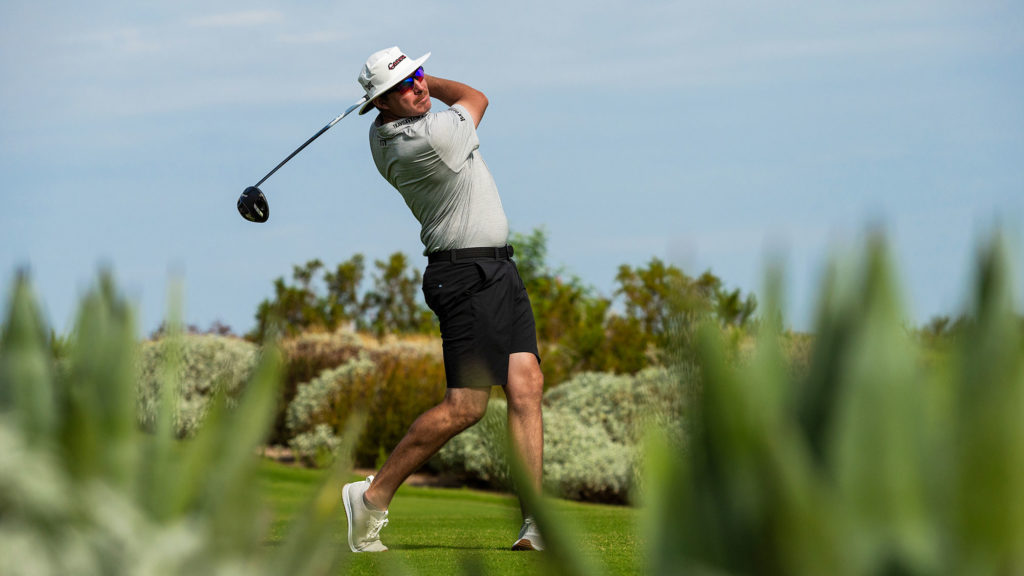An 18-hole experiment with Joel Dahmen and our 11-handicap Golf Digest colleague confirms that playing a tour pro’s drives solves a lot of problems. Just not all of them.

Joel Dahmen and I had known each other for only a few minutes, and he could already smell fear. It was just after dawn in the Arizona desert, and the PGA Tour veteran and I were standing back-to-back for a photo before teeing off on video.
“I can feel Sam’s heart beating through his shirt,” Joel said.
It wasn’t quite a competition, and even if it was, Dahmen was more like my partner. We were there to resurrect an idea Golf Digest had executed three decades earlier between writer Peter Andrews and Mark O’Meara. Dahmen and I would play 18 holes of strokeplay with one notable twist: I would tee off from the 6,552-metre tips, and Dahmen would play out the hole from my feeble drive; I’d get to play the ball miles ahead that Dahmen would launch from the 5,711-metre members tees. The question we sought to answer was how much the distance between a winner on the PGA Tour and a light-hitting golf editor
(a 10.8 handicap the morning of the experiment) was really about that – distance. Otherwise, weren’t we essentially playing the same game?
Dahmen probably knew the answer even before we reached the first tee at Scottsdale National’s “Other” course (named because it was added to the original Mine Shaft layout in 2016), but he was all-in regardless. Dahmen is a cancer survivor, a candid and thoughtful interview, and the type of guy who casually fell into a chipping competition with our crew over White Claws late in the day. But in case we needed reminding, he is also one of the best golfers in the world. For a player of his calibre, to say the difference between us was mainly about distance was more than misleading. It was insulting, too.

I’ve always had these athletic fantasies. Growing up as an ice hockey player, I dreamed about a game in which everyone but me travelled at half speed, and I could score at will. Or I was a quarterback who could zip a football with the same precision and pace I normally threw a baseball. And golf? Imagine what kind of golfer I would be if my tee shot was always reliably delivered well down the fairway.
Of course, these imagined scenarios were all absurd, but then, so was our experiment with Dahmen. The round we embarked on wasn’t quite golf if I would be afforded a generous head start on every hole, and one of Dahmen’s most prized skills would be rendered irrelevant. But it would tell us something about the unique way a tour player dissects a golf course and maybe about what holds an amateur like me back. All year long I had been flirting with breaking 80, and this would be the opportunity to do so, even if in dubious fashion. Handcuffed by playing my drives, Dahmen still identified a round under par as a worthy target.
“I believe in you,” Dahmen said as I stood over my first tee shot.
“That makes one of us,” I said.
I won’t take you through every hole, but if they were all like the first, I would have no choice. From the back tees I hit a typical weak bleeder to the right that left Dahmen 210 yards uphill to the green, which he nonchalantly handled with a 4-iron to 15 feet. From the members tees Dahmen smashed his drive to a mere 70 paces short of the green. Faced with a half wedge – one of my many throw-up zones – I stuck my approach to two feet. In the afterglow of an opening birdie, I couldn’t resist thinking: If I have a wedge in my hand every hole, how hard could this be?
Spoiler alert: very hard.
The next hole I also had a wedge in hand, but my approach sailed over the green and plugged into the back bunker. What followed was a sequence I wish could be forgotten, but it was all caught on film: two bunker shots, four (!!) putts and one PGA Tour pro who looked at me with a mixture of pity and amusement. Dahmen made birdie, I made 9, and our respective drives barely played a role. “You hit a great shot,” he said of my approach. There was a “but” in there somewhere, and he knew I didn’t need
to hear it.
“Most people can hit it OK, but it’s amazing to watch their touch and feel; they have no idea,” Dahmen would tell me later. “They try to do too much stuff, arms are flailing, and clubheads are everywhere. It turns into chaos, really.”


Dahmen is stronger than I am, generates more speed than I do and has the sort of innate sense for how a 50-foot chip should feel versus one five feet shorter. Of course, his golf swing is more efficient, but so is his mind. As in my ice-hockey fantasy, Dahmen sees the game differently. He processes it at a leisurely pace – the shot options, the optimal path to the hole, the elements he should avoid and the ones that aren’t worth his attention. Whether over tee shots or knocking in four-footers, his unhurried demeanour is as if he is folding laundry. Is Dahmen an elite golfer because he is so calm, or is his calm a byproduct of being so good? The answer might be somewhere in between.
“We practise and do all the stuff then so that we can kind of turn our brains off, and it’s muscle memory or whatever you want to call it,” Dahmen said. “We have at least one key, where I think a lot of amateurs go and just hit balls and then they get out there and they’re like, ‘Well, what am I actually doing?’”
Dahmen had me pegged. Staring down the fairway from the back of every tee, my instinct is to consider everything that could go wrong, and then be pleasantly surprised if I sidestep catastrophe. It is an exhausting way to play – chaotic, Dahmen might say – and not just in my head. When I checked my heart rate on my Apple Watch at day’s end, I saw spikes I typically see when riding a Peloton.
“There is managing expectations and then there’s having self-doubt and no belief in yourself,” Dahmen said as I contemplated one shot. “I feel like you’re crossing the line here a little bit.”
Dahmen confessed that he had feared the worst – balls dribbling in unspeakable directions, rattlesnakes nipping at his ankles as he punched out of the bush – when my actual tee shots were findable, sometimes even better. “You haven’t lost a ball yet!” he said on the front nine, which only confirmed how low he had set the bar. Of course, playing from the tips I was leaving him laughably long approaches – 280 yards on one, 300 on another when I skied the drive – but we at least avoided the sort of acrobatic recoveries our video crew was thirsting for. Twice I was faced with the humiliating reality of needing to tee off on par 3s with my driver, but both times I managed to hit the green, once even knocking it inside my playing partner.
“You actually do a lot of things pretty well,” Dahmen said at one point, which is a phrase I might have stitched onto a throw pillow. By the standard of golf Dahmen was used to playing, I was a lost cause. But on this day, I was his lost cause, and he was intent on bringing me to the finish line in one piece.
Dahmen, of course, did everything well, which is what you would expect from a player who posted his first even-par tournament round at age 10, shot 68 at age 12 and set a course-record 58 at his home course, Mesa Country Club, two years ago. Hitting high draws of 300-plus yards, Dahmen put me in positions I hadn’t known outside video games and Golden Tee, leading to three birdies in my first nine holes. The new perspective was so intoxicating I started to get greedy. On one tee, I requested Joel leave me an approach between 107 and 108 yards. On a par 3 later in the round, I said I preferred five feet below the hole. “Right to left, ideally.”
I was kidding –mostly. The whole thing felt like when I was a kid at New York’s Madison Square Garden, when we would sneak all the way down to the first row at ice hockey games. I knew I didn’t belong there, and that I wouldn’t stay long, so I figured I might as well enjoy the view while I could.

The only problem with this tour-pro fantasy is that all of me was invited. At the par-4 fifth, moments after my second birdie, Dahmen crunched a drive that left me 120 yards to the flag. But then I tugged my approach left and played the next three shots as if wielding a garden hoe, my ball twice failing to crest a mound and instead trickling back to my feet. That I wasn’t a long hitter was a given, but I could usually count on my short game to be something better than dreadful. But it turns out that my nerves were exposed the most on precise shots, and my tendency in the aftermath of a bad shot was to obsess about it even more.
I turned in six-over. Dahmen was even-par. Halfway through, he wasn’t abandoning hope.
“You could be four or five better without blinking,” he said. “If you clean up the short game on the back, you can probably shoot even. If you keep hitting fairways, I can still shoot under par.”
So we pressed on. Simple pars for both of us on 10 and 11. Another for me on 12 but a three-putt for Joel that pushed him over par for the first time. Between shots, I had taken to peppering Dahmen with a spontaneous series of golf-nerd queries. I asked what club he would use in a one-club challenge (a 7-iron), the course that plays longest on tour (Torrey Pines in wet conditions, which he equated to playing my drives), what part of his game is holding him back (mid-range putting), and the parts of other players’ games he studied with envy.
“Jordan Spieth, out of gnarly lies, still finds a way to put spin on the ball and really control his landing spot with the spin,” Dahmen said. “If you give me five balls, I can do it. But he does it on the first one all the time, and you can’t teach it. No matter how much I practise that, I can’t.”
The subtext: everything in golf is relative. Although not quite the chasm between Dahmen and me, the best golfers observe their own line between good and great. Dahmen lives with these comparisons daily. By tour standards, he is a modest hitter, averaging 292 yards (267 metres) off the tee in competition, so I wondered if, like with me, there is an element of intimidation when players knocked it past him.
“I’m used to it at this point,” he said. “I have to beat guys a different way. I’m a little bit like, ‘Hey, I’m gonna wear you out with my 7-iron versus your 9-iron’ type thing. That to me is kind of fun if you can beat him with your own game.”

We were approaching the end, and it was apparent my perspective had been warped by the experience. The pin was tucked in a left corner of the green of the par-5 15th, and I had a 9-iron in hand, with visions of drawing the ball towards the flag. But my approach never turned over. On the green, putting for birdie from 50 feet, the middle-handicapper in me had no right to be disappointed, yet I was.
Only later did I detect one counter-productive element of playing Dahmen’s drives, and it was the subtle shrinking of my targets, with little regard for my own limitations. In a typical round, I am realistic enough to aim for the middle of greens and be comfortable with anything close enough. With Dahmen, I airmailed two greens and shortsided myself often – in part because I forgot who I was.
“I’m going to be so messed up the next time I play regular golf,” I confessed.
“Does that mean I’m going to maybe have more confidence the next time I play?” Dahmen said.
“This is like a bad dream you’re going to wake up from,” I said.
A three-putt bogey meant I would need to play the final three holes in one-under to shoot 79. Dahmen was holding up his end, but I wasn’t returning the favour. When I missed the par-3 16th left, his chip came up short, and he added another bogey. The pro’s aspirations of a round under par were dashed, but my quest was still alive. We each chalked up lacklustre pars on 16 and 17, but Dahmen crushed his drive on the par-5 18th 365 yards and down to the bottom of the hill. The last time I had this little in on a par 5 was… (checks notes)… never, and the opportunity before me was clear.
Standing over the ball I thought about how Golf Digest’s Andrews shot 82 in his round with O’Meara in 1991, and that my best score for the year was 81, and here I had 147 into the green and a slightly downhill lie and I… chunked my approach into a bunker.
“I’m not disappointed in you,” Dahmen said. “I’m disappointed for us.”
The day’s biggest moment yielded my worst swing, but the round wasn’t over yet.
“Any advice?” I asked as I descended into the sand.
“You could pray.”
The finish was a blur. I flubbed my first bunker shot and then my second. If the purpose of the experiment was to confirm a PGA Tour player’s advantage extended through the bag, my subconscious must have felt compelled to drive the point home. That I blasted out to 12 feet and sank the putt for bogey was of little solace.

I finished with 81, Dahmen with a 75. I was crestfallen, a little embarrassed, but not surprised. Dahmen might have been introduced to my maddening golf game for the first time that morning, but I had been living with it for years.
“That was a lot of fun,” Dahmen said. “You hit it pretty good. You actually putted OK except for that one hole, but the chipping was, uh, suspect.”
Later, after we reconvened for lunch and a photo shoot at a golf-training facility Dahmen owns with partners in Scottsdale, he found time to tell my golf-mad teenage son over FaceTime that I had exceeded his expectations – in every way but one. That part Dahmen still wanted to fix. He was in socks and no shoes, a T-shirt and a Seattle Mariners baseball cap, and not even the flow of spiked seltzer could rinse away the lingering memories of my misadventures with a wedge. I fanned it too far inside on chips, he said, and my hands were too far forward in the sand. It might work some of the time, but under pressure I was a disaster. Dahmen went on like this for about 15 minutes, and it started to make sense.
A week later, I was about to play nine holes with my son at home in New York. Dahmen was playing the PGA Tour season opener in Napa, California, but he texted me back quickly when I told him the bunker tip was starting to click. He was eager to know of my progress, though we both knew my standard would be nothing like his. As a golfer, I was back in the cheap seats but hoping I could inch closer to the front row on my own.


Dahmen’s take
I was terrified Sam would hit a bunch of crooked drives, and I’d have rattlesnakes snapping at my heels all day, but he actually hit it pretty straight. What Sam struggled with was (how do I put this lightly?) not really having a clue strategically.
Most average players struggle less with technique and more from bad decisions. Sam’s short game kept us all on edge. Not knowing what shot to hit or what mistake to avoid is what derails a round. Tour pros make bad swings all the time, but players like Sam pay for bad swings more than they need to.
Even at our level, some guys stand out. Kevin Kisner isn’t the longest hitter or best putter, but it’s hard to think of a guy who squeezes more out of his game because of how efficient he is around the greens. Do I wish I could hit the ball like Rory McIlroy? Of course. But man, I’d love to even have a career like Kevin Kisner’s.
The best way for average players to score better right away is to not allow mistakes to snowball. Go with the shots you trust, and avoid the ones that risk disaster.



